A Report on Organizational Conflict: Causes, Strategies, and Effects
VerifiedAdded on 2023/04/21
|5
|1123
|307
Report
AI Summary
This report delves into the complexities of organizational conflict, identifying its primary causes, such as resource limitations, managerial faults, and communication gaps. It examines the effects of conflict, ranging from decreased productivity to potential violence, while also acknowledging the potential for positive outcomes like increased creativity. The report highlights various conflict resolution styles, based on the Thomas-Kilmann instrument, including competing, collaborating, avoiding, accommodating, and compromising. It emphasizes the collaborative style as the most suitable for most organizations, detailing its benefits for both management and employees, while also acknowledging situations where other strategies might be more appropriate. The report also discusses the expected outcomes of each strategy, providing a comprehensive overview of conflict management in the workplace and its importance for organizational success.
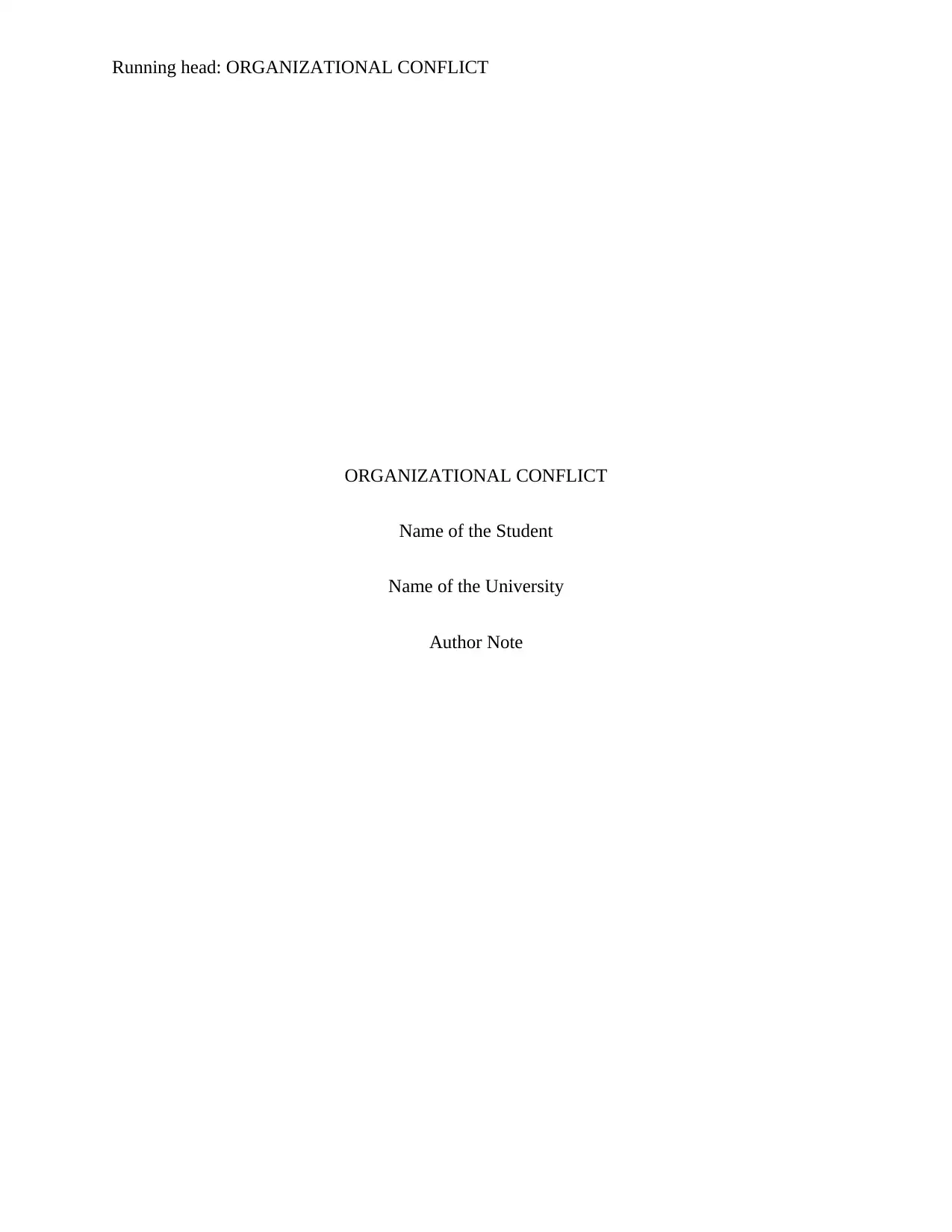
Running head: ORGANIZATIONAL CONFLICT
ORGANIZATIONAL CONFLICT
Name of the Student
Name of the University
Author Note
ORGANIZATIONAL CONFLICT
Name of the Student
Name of the University
Author Note
Paraphrase This Document
Need a fresh take? Get an instant paraphrase of this document with our AI Paraphraser
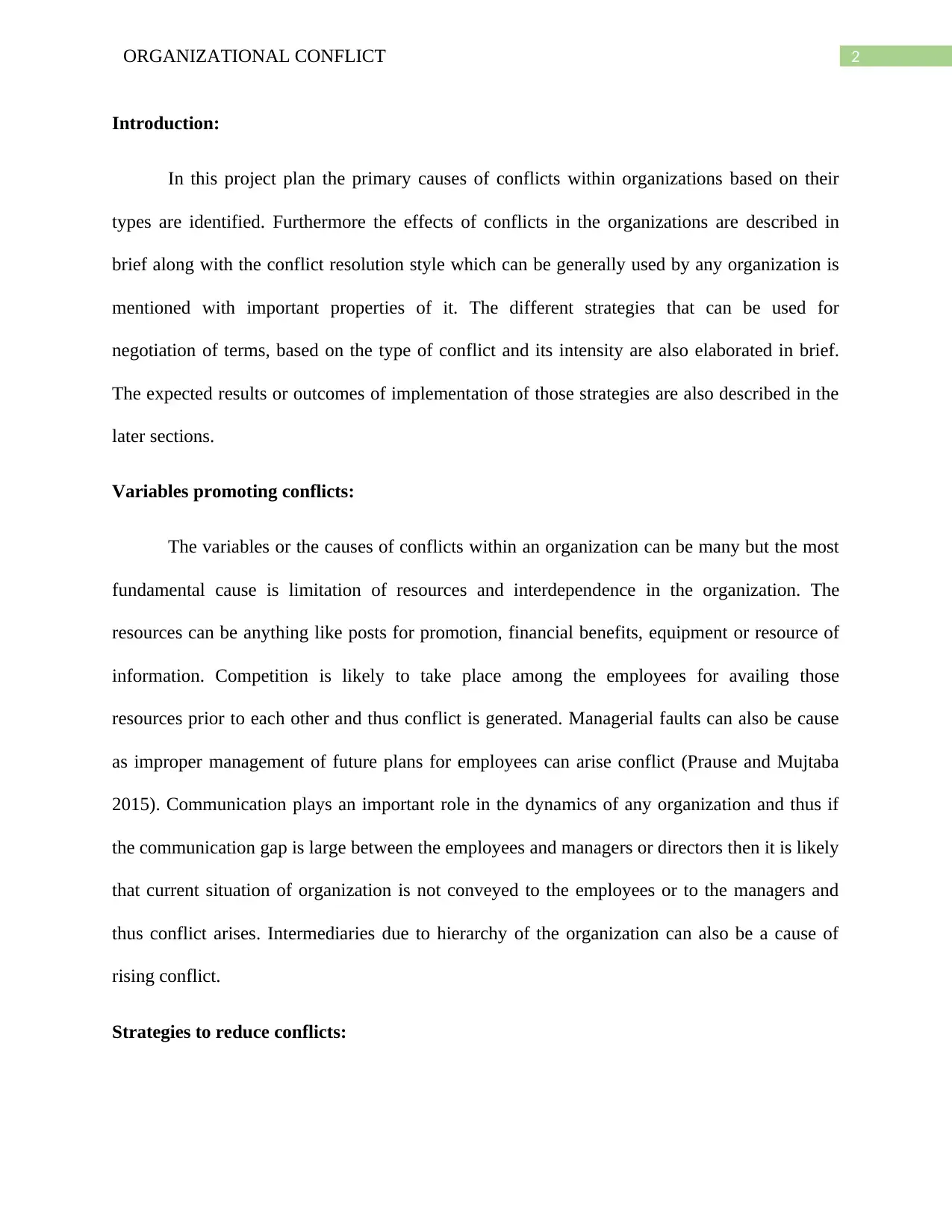
2ORGANIZATIONAL CONFLICT
Introduction:
In this project plan the primary causes of conflicts within organizations based on their
types are identified. Furthermore the effects of conflicts in the organizations are described in
brief along with the conflict resolution style which can be generally used by any organization is
mentioned with important properties of it. The different strategies that can be used for
negotiation of terms, based on the type of conflict and its intensity are also elaborated in brief.
The expected results or outcomes of implementation of those strategies are also described in the
later sections.
Variables promoting conflicts:
The variables or the causes of conflicts within an organization can be many but the most
fundamental cause is limitation of resources and interdependence in the organization. The
resources can be anything like posts for promotion, financial benefits, equipment or resource of
information. Competition is likely to take place among the employees for availing those
resources prior to each other and thus conflict is generated. Managerial faults can also be cause
as improper management of future plans for employees can arise conflict (Prause and Mujtaba
2015). Communication plays an important role in the dynamics of any organization and thus if
the communication gap is large between the employees and managers or directors then it is likely
that current situation of organization is not conveyed to the employees or to the managers and
thus conflict arises. Intermediaries due to hierarchy of the organization can also be a cause of
rising conflict.
Strategies to reduce conflicts:
Introduction:
In this project plan the primary causes of conflicts within organizations based on their
types are identified. Furthermore the effects of conflicts in the organizations are described in
brief along with the conflict resolution style which can be generally used by any organization is
mentioned with important properties of it. The different strategies that can be used for
negotiation of terms, based on the type of conflict and its intensity are also elaborated in brief.
The expected results or outcomes of implementation of those strategies are also described in the
later sections.
Variables promoting conflicts:
The variables or the causes of conflicts within an organization can be many but the most
fundamental cause is limitation of resources and interdependence in the organization. The
resources can be anything like posts for promotion, financial benefits, equipment or resource of
information. Competition is likely to take place among the employees for availing those
resources prior to each other and thus conflict is generated. Managerial faults can also be cause
as improper management of future plans for employees can arise conflict (Prause and Mujtaba
2015). Communication plays an important role in the dynamics of any organization and thus if
the communication gap is large between the employees and managers or directors then it is likely
that current situation of organization is not conveyed to the employees or to the managers and
thus conflict arises. Intermediaries due to hierarchy of the organization can also be a cause of
rising conflict.
Strategies to reduce conflicts:
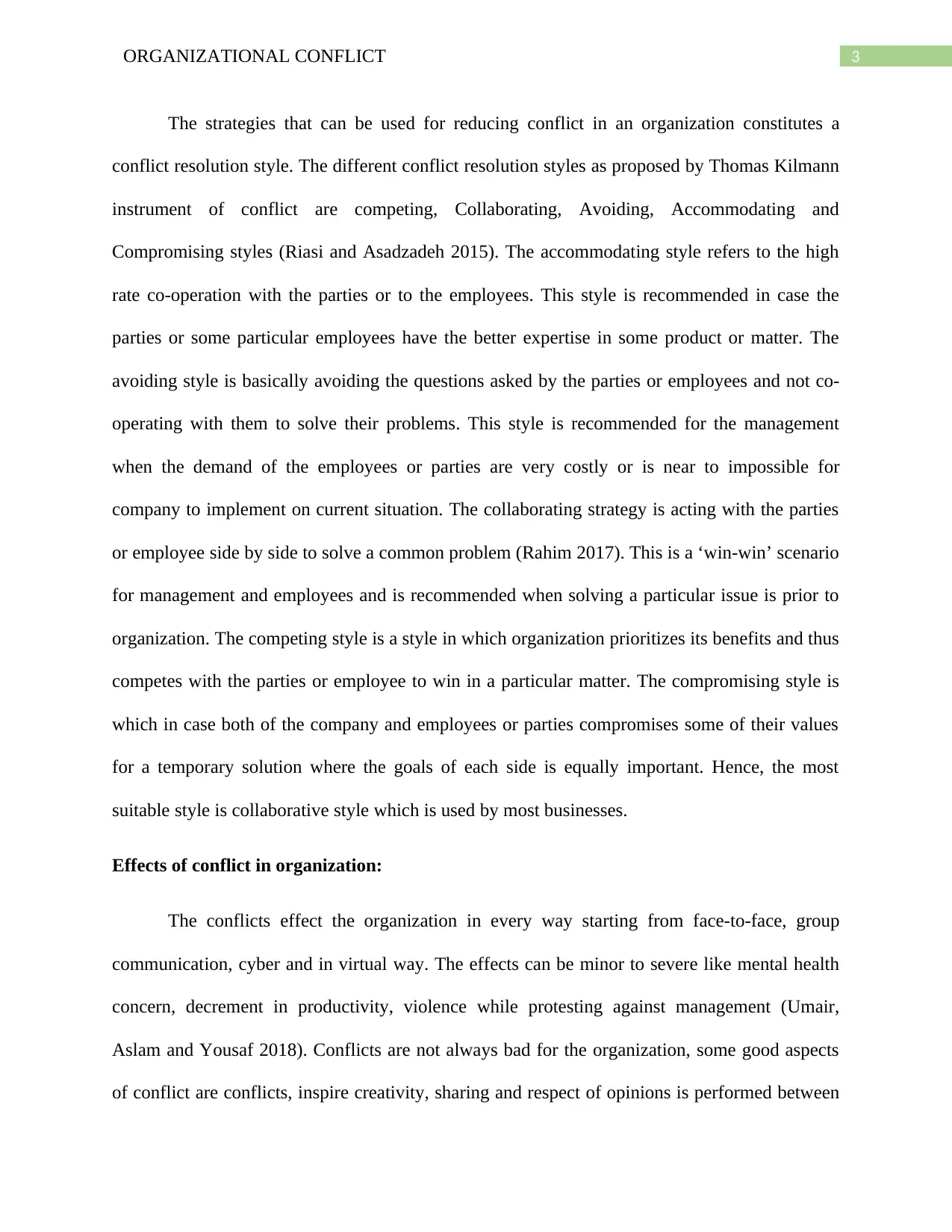
3ORGANIZATIONAL CONFLICT
The strategies that can be used for reducing conflict in an organization constitutes a
conflict resolution style. The different conflict resolution styles as proposed by Thomas Kilmann
instrument of conflict are competing, Collaborating, Avoiding, Accommodating and
Compromising styles (Riasi and Asadzadeh 2015). The accommodating style refers to the high
rate co-operation with the parties or to the employees. This style is recommended in case the
parties or some particular employees have the better expertise in some product or matter. The
avoiding style is basically avoiding the questions asked by the parties or employees and not co-
operating with them to solve their problems. This style is recommended for the management
when the demand of the employees or parties are very costly or is near to impossible for
company to implement on current situation. The collaborating strategy is acting with the parties
or employee side by side to solve a common problem (Rahim 2017). This is a ‘win-win’ scenario
for management and employees and is recommended when solving a particular issue is prior to
organization. The competing style is a style in which organization prioritizes its benefits and thus
competes with the parties or employee to win in a particular matter. The compromising style is
which in case both of the company and employees or parties compromises some of their values
for a temporary solution where the goals of each side is equally important. Hence, the most
suitable style is collaborative style which is used by most businesses.
Effects of conflict in organization:
The conflicts effect the organization in every way starting from face-to-face, group
communication, cyber and in virtual way. The effects can be minor to severe like mental health
concern, decrement in productivity, violence while protesting against management (Umair,
Aslam and Yousaf 2018). Conflicts are not always bad for the organization, some good aspects
of conflict are conflicts, inspire creativity, sharing and respect of opinions is performed between
The strategies that can be used for reducing conflict in an organization constitutes a
conflict resolution style. The different conflict resolution styles as proposed by Thomas Kilmann
instrument of conflict are competing, Collaborating, Avoiding, Accommodating and
Compromising styles (Riasi and Asadzadeh 2015). The accommodating style refers to the high
rate co-operation with the parties or to the employees. This style is recommended in case the
parties or some particular employees have the better expertise in some product or matter. The
avoiding style is basically avoiding the questions asked by the parties or employees and not co-
operating with them to solve their problems. This style is recommended for the management
when the demand of the employees or parties are very costly or is near to impossible for
company to implement on current situation. The collaborating strategy is acting with the parties
or employee side by side to solve a common problem (Rahim 2017). This is a ‘win-win’ scenario
for management and employees and is recommended when solving a particular issue is prior to
organization. The competing style is a style in which organization prioritizes its benefits and thus
competes with the parties or employee to win in a particular matter. The compromising style is
which in case both of the company and employees or parties compromises some of their values
for a temporary solution where the goals of each side is equally important. Hence, the most
suitable style is collaborative style which is used by most businesses.
Effects of conflict in organization:
The conflicts effect the organization in every way starting from face-to-face, group
communication, cyber and in virtual way. The effects can be minor to severe like mental health
concern, decrement in productivity, violence while protesting against management (Umair,
Aslam and Yousaf 2018). Conflicts are not always bad for the organization, some good aspects
of conflict are conflicts, inspire creativity, sharing and respect of opinions is performed between
⊘ This is a preview!⊘
Do you want full access?
Subscribe today to unlock all pages.

Trusted by 1+ million students worldwide
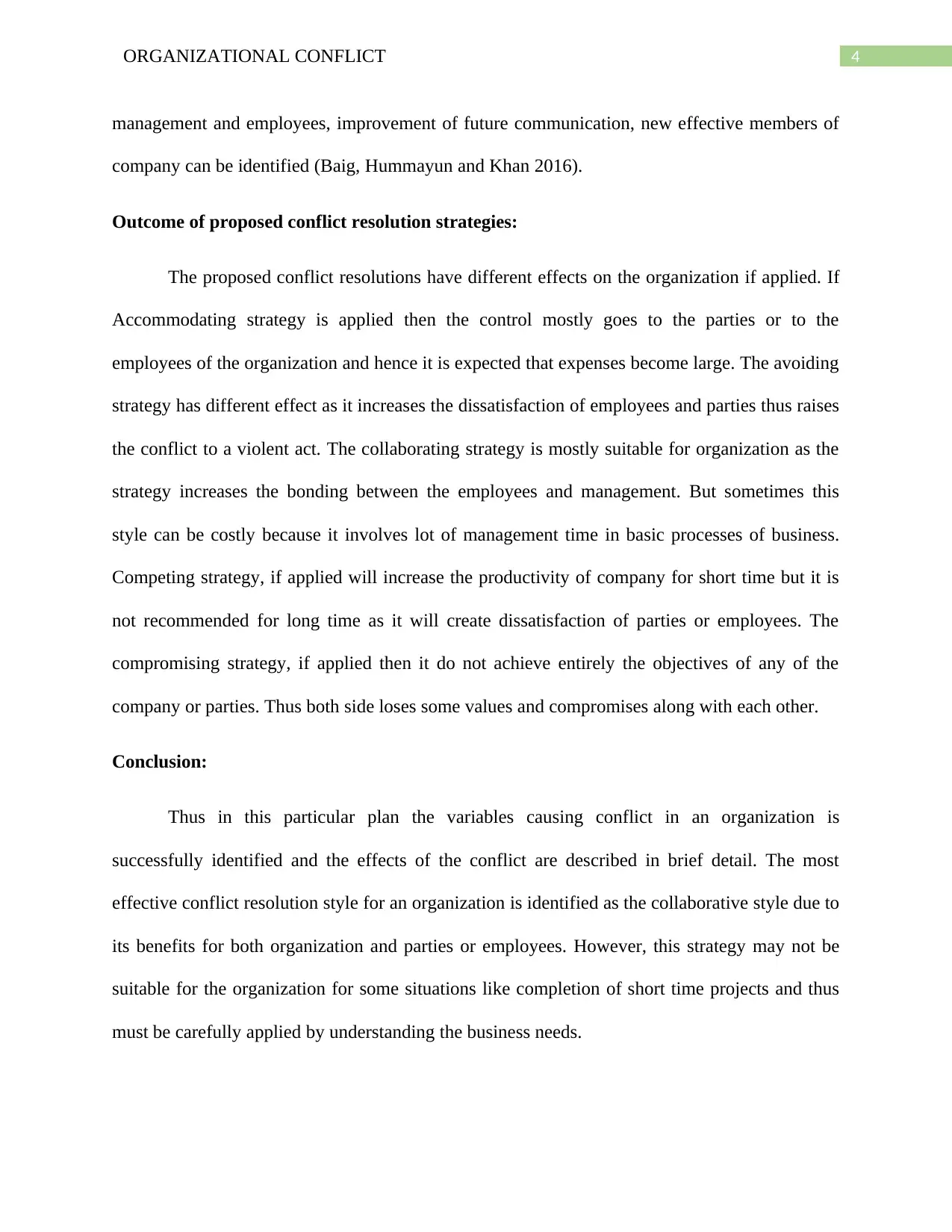
4ORGANIZATIONAL CONFLICT
management and employees, improvement of future communication, new effective members of
company can be identified (Baig, Hummayun and Khan 2016).
Outcome of proposed conflict resolution strategies:
The proposed conflict resolutions have different effects on the organization if applied. If
Accommodating strategy is applied then the control mostly goes to the parties or to the
employees of the organization and hence it is expected that expenses become large. The avoiding
strategy has different effect as it increases the dissatisfaction of employees and parties thus raises
the conflict to a violent act. The collaborating strategy is mostly suitable for organization as the
strategy increases the bonding between the employees and management. But sometimes this
style can be costly because it involves lot of management time in basic processes of business.
Competing strategy, if applied will increase the productivity of company for short time but it is
not recommended for long time as it will create dissatisfaction of parties or employees. The
compromising strategy, if applied then it do not achieve entirely the objectives of any of the
company or parties. Thus both side loses some values and compromises along with each other.
Conclusion:
Thus in this particular plan the variables causing conflict in an organization is
successfully identified and the effects of the conflict are described in brief detail. The most
effective conflict resolution style for an organization is identified as the collaborative style due to
its benefits for both organization and parties or employees. However, this strategy may not be
suitable for the organization for some situations like completion of short time projects and thus
must be carefully applied by understanding the business needs.
management and employees, improvement of future communication, new effective members of
company can be identified (Baig, Hummayun and Khan 2016).
Outcome of proposed conflict resolution strategies:
The proposed conflict resolutions have different effects on the organization if applied. If
Accommodating strategy is applied then the control mostly goes to the parties or to the
employees of the organization and hence it is expected that expenses become large. The avoiding
strategy has different effect as it increases the dissatisfaction of employees and parties thus raises
the conflict to a violent act. The collaborating strategy is mostly suitable for organization as the
strategy increases the bonding between the employees and management. But sometimes this
style can be costly because it involves lot of management time in basic processes of business.
Competing strategy, if applied will increase the productivity of company for short time but it is
not recommended for long time as it will create dissatisfaction of parties or employees. The
compromising strategy, if applied then it do not achieve entirely the objectives of any of the
company or parties. Thus both side loses some values and compromises along with each other.
Conclusion:
Thus in this particular plan the variables causing conflict in an organization is
successfully identified and the effects of the conflict are described in brief detail. The most
effective conflict resolution style for an organization is identified as the collaborative style due to
its benefits for both organization and parties or employees. However, this strategy may not be
suitable for the organization for some situations like completion of short time projects and thus
must be carefully applied by understanding the business needs.
Paraphrase This Document
Need a fresh take? Get an instant paraphrase of this document with our AI Paraphraser
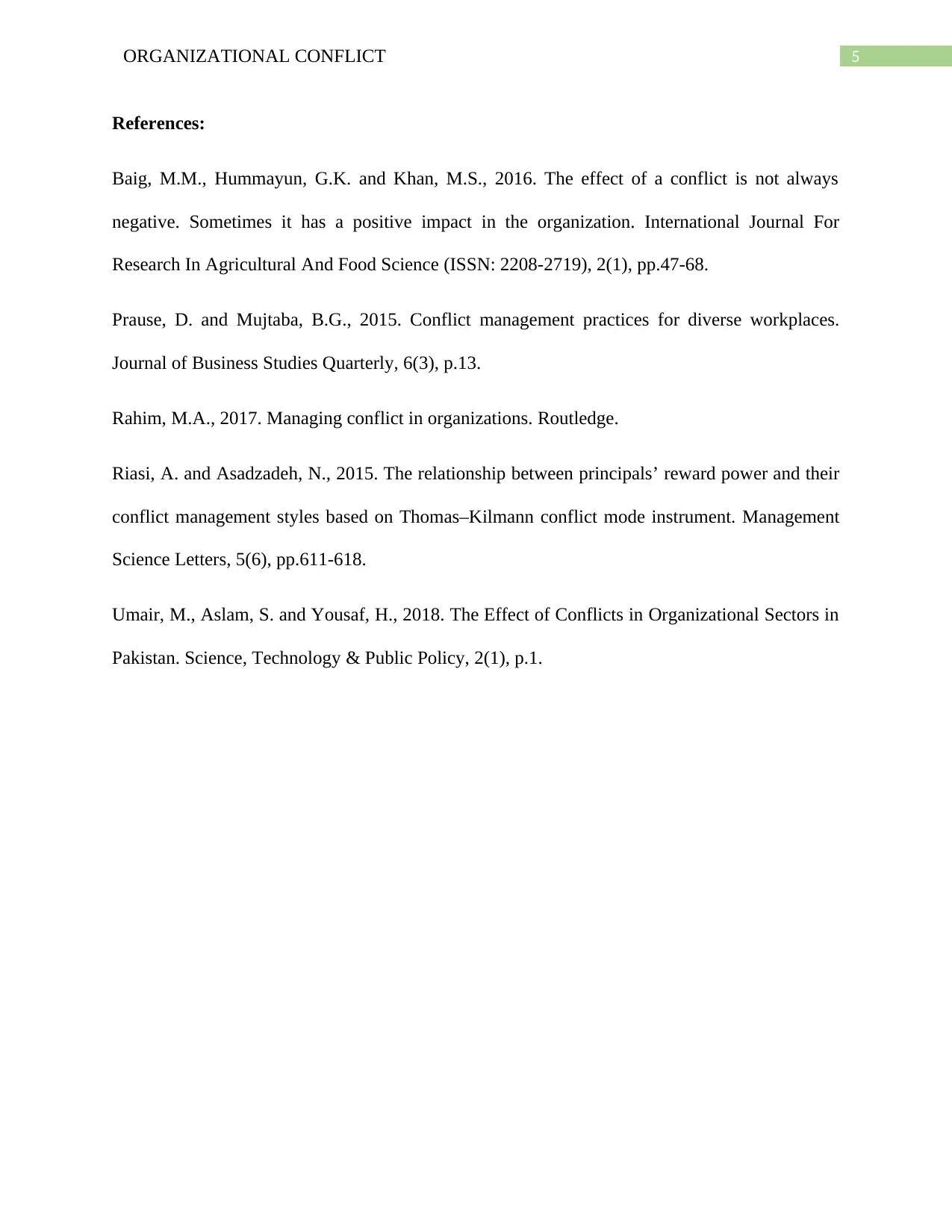
5ORGANIZATIONAL CONFLICT
References:
Baig, M.M., Hummayun, G.K. and Khan, M.S., 2016. The effect of a conflict is not always
negative. Sometimes it has a positive impact in the organization. International Journal For
Research In Agricultural And Food Science (ISSN: 2208-2719), 2(1), pp.47-68.
Prause, D. and Mujtaba, B.G., 2015. Conflict management practices for diverse workplaces.
Journal of Business Studies Quarterly, 6(3), p.13.
Rahim, M.A., 2017. Managing conflict in organizations. Routledge.
Riasi, A. and Asadzadeh, N., 2015. The relationship between principals’ reward power and their
conflict management styles based on Thomas–Kilmann conflict mode instrument. Management
Science Letters, 5(6), pp.611-618.
Umair, M., Aslam, S. and Yousaf, H., 2018. The Effect of Conflicts in Organizational Sectors in
Pakistan. Science, Technology & Public Policy, 2(1), p.1.
References:
Baig, M.M., Hummayun, G.K. and Khan, M.S., 2016. The effect of a conflict is not always
negative. Sometimes it has a positive impact in the organization. International Journal For
Research In Agricultural And Food Science (ISSN: 2208-2719), 2(1), pp.47-68.
Prause, D. and Mujtaba, B.G., 2015. Conflict management practices for diverse workplaces.
Journal of Business Studies Quarterly, 6(3), p.13.
Rahim, M.A., 2017. Managing conflict in organizations. Routledge.
Riasi, A. and Asadzadeh, N., 2015. The relationship between principals’ reward power and their
conflict management styles based on Thomas–Kilmann conflict mode instrument. Management
Science Letters, 5(6), pp.611-618.
Umair, M., Aslam, S. and Yousaf, H., 2018. The Effect of Conflicts in Organizational Sectors in
Pakistan. Science, Technology & Public Policy, 2(1), p.1.
1 out of 5
Related Documents
Your All-in-One AI-Powered Toolkit for Academic Success.
+13062052269
info@desklib.com
Available 24*7 on WhatsApp / Email
![[object Object]](/_next/static/media/star-bottom.7253800d.svg)
Unlock your academic potential
Copyright © 2020–2025 A2Z Services. All Rights Reserved. Developed and managed by ZUCOL.





